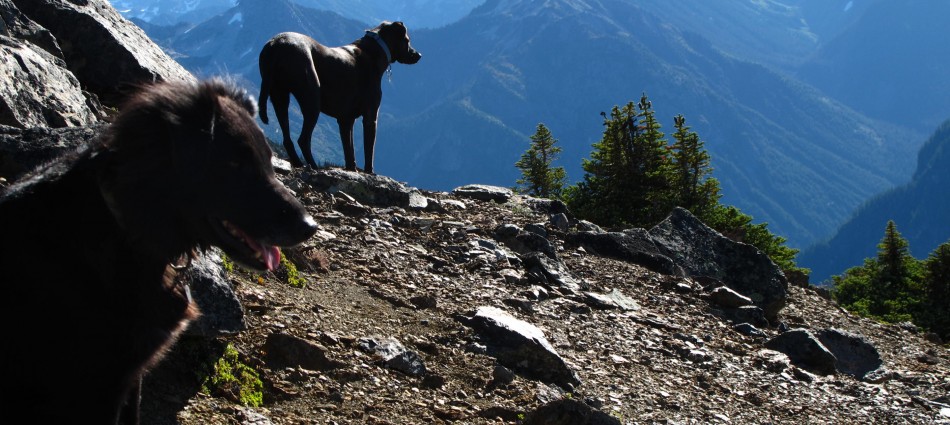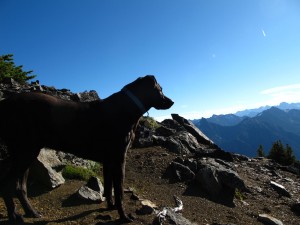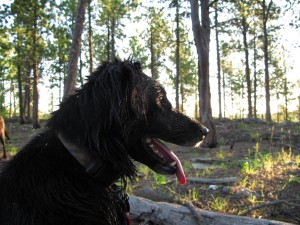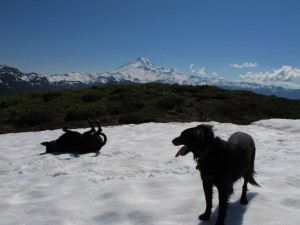Pick-up Dogs How Two Rescue Dogs Save the West from Being Won

The Economic Value of Wilderness
I’ve been working on the idea of the value of wilderness and nature from the point of view of an economist, which is difficult because I’m not an economist. Nevertheless, by definition economists have a lot to tell us about nature and wilderness, and I want to learn from their perspective. Economics is the study of management of scarce resources and, as a pseudo-science, economics attempts to calculate, using graphs and equations, how members of society value the scarce amenities with which we live.
There are a lot of myths attached to how economists attempt to measure the value of abstract concepts such as wilderness and nature. Firstly, economists do not see the market as the solution to all problems. Certainly, all students of economics learn that private markets are perfectly efficient if left alone with no interference. However, a perfect private market exists in theoretical textbooks. Markets are only efficient given that there we have truly perfect competition among a hyper-infinite continuum of buyers and sellers, perfect knowledge among these buyers and sellers, that there are no public goods, no externalities, no information problems, no transaction costs, no taxes, no common property, no diminishing marginal returns in consumption and production, and no other distortions between the costs paid by buyers and the benefits received by sellers. Externalities, here, really are a killer because there is no way to recognize the full cost of them. So, in a sense, the market, especially when left to itself, cannot solve all problems.
Another myth is that economists only use market prices to evaluate solutions to potential environmental problems. It’s true, it’s easy to use market prices, whenever possible, to carry out evaluations of the benefits received from a resource or lack of said resource. Indeed, a market price would tell us how much members of society actually value these scarce resources under consideration. Given two houses of equal dimensions, all else being equal, the rational consumer will choose the house that is located in an area with cleaner air. That is easy to measure.
Yet, how do we place value on an irreplaceable resource? It goes back to the classic economics question: if nobody wanted diamonds, would they be scarce? Or, why is a life-sustaining resource such as water seen as practically “free” in the developed world while a tiny useless rock can be worth many thousands of dollars?
Economics attempts to measure these scarce resources, but many things cannot be measured in monetary units. If we could measure what lawyers call “pain and suffering,” we could see that the economic value of human-health damages resulting from environmental pollution could be higher than the sum of health-care costs and lost wages (lost productivity).
Remember that economic profits are not the same as accounting profits, which only measure the difference between revenue and costs associated with said revenue. Economic profits include another factor: opportunity costs. You can put a price on the lost opportunity costs of a shrinking life expectancy created by polluted air and water, but until that can be demonstrably measured, we are the proverbial frog waiting in the water that is about to be boiled alive.
Will we be boiled alive?
How much is it worth it to you to have an extra mile of visibility when you stand on a cliff on your favorite hike?
Would you be willing to sacrifice a percentage point or two in the unemployment rate in your community to still be able to bike without having to wait an extra 10 minutes every hour at a railroad crossing for a 2-mile long coal train to pass?
Would you be willing to give up $10,000 in salary to be able to canoe in a lake with pristine water rather than one where pollution is dumped?
Many economists do make a living making the calculations that clearly illustrate that laissez-faire policy that allow the market failures of extreme pollution lead not to a social efficiency but an utter and complete market inefficiency. In some cases, their results can be clearly illustrated with a market price. In others, they cannot limit their analyses to financial considerations but end up using money as a unit of measurement because there is no other more convenient unit.
So back to my question: How do we measure the value of wilderness?
This question becomes especially difficult during an era when progress is measured in ever-increasing material well-being aka income growth. A time when homo economicus is envisioned by marketers as a being with insatiable demands. The conventional growth model eschews moral and ethical considerations, ignores distributive equity, abolishes “the common good,” and what we are left with is a Tragedy of the Commons.
Will our insatiable appetite for energy outweigh our need for clean air? More than half of the world’s land-mass has been transformed for human purposes and more than half of the planet’s accessible fresh water is being used by people.
It’s hard to contemplate what many are calling a “sustainable” lifestyle because, in theory (at least in theory), almost everything is replaceable. It is perfectly okay, it is perfectly logical and rational, to argue for the preservation of a particular species or the preservation of a particular landscape. But that has to be done on its own, for its own sake, because this landscape is intrinsically what we want or this species is intrinsically important to preserve, but it cannot fall under the heading of sustainability. Sustainability doesn’t require that any particular species of owl or any particular species of fish or any particular tract of forest be preserved. Even with our best efforts, species will disappear. Since the beginning of life on earth, some 98% of species that ever existed have gone extinct, and a good number of them were extinct long before homo sapiens took the earth. In other words, there is no reason for our society to feel guilty about using up aluminum as long as we leave behind a capacity to perform the same or analogous functions using other kinds of materials.
As a fan of Gifford Pinchot, I like to tout his national forests and his conservation work as being for the “greatest good for the greatest number.” National forests, and not national parks (because of their stringent canine rules), are where I can best enjoy the beauties of nature with my dogs. Yet mathematically, Pinchot’s maxim doesn’t make sense. You cannot maximize for two variables at the same time. Biologically, an organism needs a source of energy to exist. For human beings, this is about 1600 maintenance kilocalories a day. Any more than this number are considered “work calories.” If our goal is to maximize population it is obvious that we must make the work calories per person approach as close to zero as possible. No gourmet meals, no vacations, no sports, no music, no literature, no art. No unnecessary movement. No calories expended for irrational purposes. Needless to say, we can conclude that maximizing population does not maximize goods or benefits to society. So, as population increases, goods per person will have to diminish to accommodate future generations. Yet, many of us still live with the attitude that we live in a race to consume as much as possible. Where is the tipping point? We don’t know.
An economist would say that sustainability is about distributional equity between the present and the future. Going back to market prices for an abstract concept like wilderness, the future cannot be represented in today’s market. How can people a few generations from now be represented in today’s market? People in the future don’t participate in today’s market and they have no reason for saying, “Oh shucks, our ruined open spaces come as the result of ordinary supply and demand, ordinary market behavior, which were supposed to take care of whatever obligation we have to the future.” Natural resource extractors do not take into account “scarcity rent,” the indirect but very real costs of increased scarcity. It doesn’t take an economist to figure out that left to its own devices, the invisible hand of the market cannot control how quickly resources are depleted and The Future is left with the consequences.
Somehow, wilderness and open space will have to be seen as investments. We, as a society, have done a poor job with intergenerational equity. A boom and bust mentality playing a winner take all game has left us with a lot of tough decisions at a precarious crossroads. Me, I’ll take open spaces, national forests and wilderness areas to play in with my dogs. But that’s the easy answer. Unfortunately, we live in a world in which materiality dominates; the “fake plastic trees” that the band Radiohead sing about are more poignant because we all all participate and have come to accept the material world. What’s wrong with plastic trees anyways?
The answer to this last question lies in the social and symbolic meanings that wilderness and open space offer us. Nearly impossible to measure, we are presented with the wilderness paradox that Aldo Leopold presents us in his essay,“Marshland Elegy,” a call to defend prairies, marshlands, cranes and the other flora and fauna that inhabit these habitats:“The ultimate value in these marshes is wildness, and the crane is wildness incarnate. But all conservation of wildness is self-defeating, for to cherish we must see and fondle, and when enough have seen and fondled, there is no wilderness left to cherish.” This paradox indicates that there will probably never be a time when people will respect wilderness for what it is, because our land ethic is based on the notion of property and holding property. As Leopold points out in his landmark essay, “The Land Ethic,” the “most [valuable] members of the land community have no economic value. Wildflowers and songbirds are examples.” So, how can we put a price on wilderness? How can I put a price on being able to walk with my wife and two dogs and share a restorative experience for our souls?
The problem with many contemporary conservation movements is that they still treat wilderness as a commodity. In his forward to The Sand County Almanac, Leopold writes, “[l]ike winds and sunsets, wild things were taken for granted until progress began to do away with them.” He goes on to state, “[w]e abuse land because we regard it as a commodity belonging to us. When we see land as a community to which we belong, we may begin to use it with love and respect.” Does the resolution of such debates always have to come back to economics? Do our peace of mind, the sanctity of our souls and responsibility to where we live not factor into the political decision-making processes of setting lands aside for future generations? Nature, really the care of our own backyard, is not a commodity but a civic responsibility as sacred as family and home. It just hasn’t been marketed as well as all the other things we have been coerced to buy.
This entry borrows from the work of Nobel Laureate economist Robert Solow’s “An Almost Practical Step Towards Sustainability”
Don Fullerton and Robert Stavins’ “How Economists See the Environment,”
William Rees’s “Economics and Sustainability: Conflict or Convergence? (An Ecological Economics Perspective)”
For discussions of this type, Buy the book



